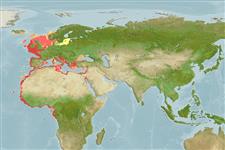>
Eupercaria/misc (Various families in series Eupercaria) >
Sciaenidae (Drums or croakers)
Etymology: Argyrosomus: Greek, argyros = silvered, silver + Greek, soma = body (Ref. 45335).
Environment: milieu / climate zone / depth range / distribution range
Ökologie
seewasser; brackwasser benthopelagisch; ozeanodrom (Ref. 51243); tiefenbereich 15 - 300 m (Ref. 2683). Subtropical; 65°N - 6°S, 23°W - 36°E
Eastern Atlantic: Norway to Gibraltar and Congo, including the Mediterranean and the Black Sea. Migrated to the Red Sea via the Suez Canal.
Length at first maturity / Size / Gewicht / Alter
Maturity: Lm ?, range 80 - ? cm
Max length : 230 cm TL Männchen/unbestimmt; (Ref. 5377); common length : 150 cm TL Männchen/unbestimmt; (Ref. 3593); max. veröff. Gewicht: 103.0 kg (Ref. 11036)
Rückenflossenstacheln (insgesamt) : 10 - 11; Rückenflossenweichstrahlen (insgesamt) : 27 - 29. Rough scales, Second dorsal fin (soft ray) twice as long as first, spiny rayed dorsal fin (Ref. 35388).
Adults are found inshore and shelf waters, close to bottom as well as in surface and mid-waters, pursuing shoals of clupeids and mugilids. They congregate inshore to spawn during spring and summer. Juveniles and sub-adults enter estuaries and coastal lagoons (Ref. 3593). Both adults and juveniles are migratory moving along shore or offshore-onshore in response to temperature change (Ref. 11025). Feed on fishes and swimming crustaceans.
Chao, L.N. and E. Trewavas, 1990. Sciaenidae. p. 813-826. In J.C. Quero, J.C. Hureau, C. Karrer, A. Post and L. Saldanha (eds.) Check-list of the fishes the eastern tropical Atlantic (CLOFETA). JNICT, Lisbon; SEI, Paris; and UNESCO, Paris. Vol. 2. (Ref. 3593)
IUCN Rote Liste Status (Ref. 130435: Version 2024-1)
Bedrohung für Menschen
Harmless
Nutzung durch Menschen
Fischereien: kommerziell; Sportfisch: ja
Tools
Zusatzinformationen
Download XML
Internet Quellen
Estimates based on models
Preferred temperature (Ref.
123201): 13.3 - 19.4, mean 15.3 °C (based on 169 cells).
Phylogenetic diversity index (Ref.
82804): PD
50 = 0.5020 [Uniqueness, from 0.5 = low to 2.0 = high].
Bayesian length-weight: a=0.00832 (0.00757 - 0.00914), b=3.07 (3.05 - 3.09), in cm total length, based on LWR estimates for this species (Ref.
93245).
Trophic level (Ref.
69278): 4.3 ±0.75 se; based on food items.
Widerstandsfähigkeit (Ref.
120179): niedrig, Verdopplung der Population dauert 4,5 - 14 Jahre. (K=0.09).
Prior r = 0.28, 95% CL = 0.19 - 0.42, Based on 3 data-limited stock assessments.
Fishing Vulnerability (Ref.
59153): Very high vulnerability (79 of 100).
Climate Vulnerability (Ref.
125649): Moderate to high vulnerability (48 of 100).
Nutrients (Ref.
124155): Calcium = 18.3 [6.5, 50.3] mg/100g; Iron = 0.438 [0.149, 1.307] mg/100g; Protein = 19.4 [17.5, 21.4] %; Omega3 = 0.322 [0.172, 0.553] g/100g; Selenium = 34.1 [11.0, 127.8] μg/100g; VitaminA = 11.8 [3.7, 39.9] μg/100g; Zinc = 0.471 [0.336, 0.696] mg/100g (wet weight); based on
nutrient studies.
